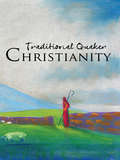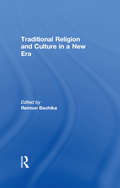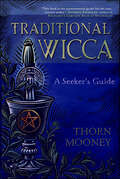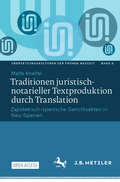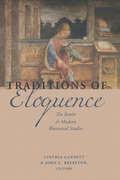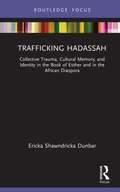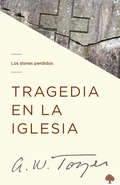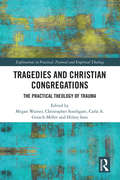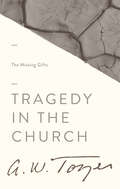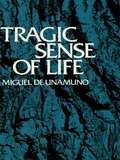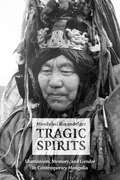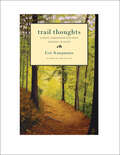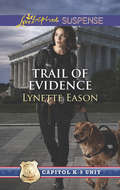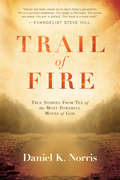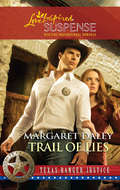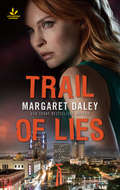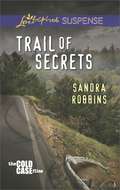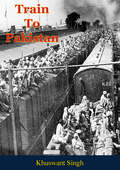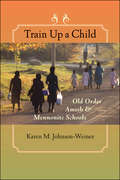- Table View
- List View
Traditional Quaker Christianity
by Susan Smith Terry Wallace John 'Jack' Smith Arthur BerkDo Quakers really worship in silence? Why don't they plan their worship services beforehand? Why do Friends make decisions on church business without voting? Can I know Jesus, guiding and teaching me? Where does true peace come from? Traditional Quaker Christianity offers the reader a means to explore the time-honored faith of Friends (Quakers), describes how modern-day Conservative Friends put that faith into everyday practice, and outlines the reasons for many of Friends' distinctive ways. The book's purpose is to assist people seeking a living faith in Christ Jesus, Who is present and powerful in the midst of all His people. Traditional Quaker Christianity can be useful not only to the individual seeker, but also as a study guide for small groups of new Friends and long-time Quakers seeking to go deeper in their spiritual pilgrimage. Several questions at the end of each section help readers relate the material to their own lives and provide a starting point for discussion.
Traditional Religion and Culture in a New Era
by Reimon BachikaWhere will postmodern culture lead us in the twenty-first century? Will it destroy traditional cultures together with the old, established religions that were its foundation? These questions and the new concerns they evoke are explored in this important collection of original essays. Contributors challenge entrenched assumptions about what many social scientists consider irreversible cultural trends. These include cultural differentiation, emphasis on individual identity, movement toward religion as a private act rather than a community commitment, and above all, emphasis on the relativity of all knowledge and values.The volume asserts three lines of argument in opposition to these trends. The first is the teleological significance of traditional religions and archaic knowledge. History can be said to have no goal, but the same must not follow for human culture. One can conceive individually of a hundred goals to live for. However, the quality of life cannot be that diverse. Taken to the extreme, cultural particularity and philosophical nihilism are insults to the life that emerged on our planet eons ago. Second, this volume emphasizes moral concern and the importance of universal values. Ideas of human well being have been formulated from ancient times. Religious beliefs invariably contain statements of value in the form of commandments and exhortations that express fundamental goals for a quality of life. Third, the nature of religion and spirituality is discussed. Religion today has become controversial socially, and marginal sociologically. The role of religion in society is sometimes problematic or abused, but it is also underestimated and misunderstood. The authors suggest that contemporary religion might best be viewed as non-ideological spiritual culture. This, in turn, looks to a future in which religion and culture coalesce.This volume includes an international cast of scholars from Japan, the United States, Canada, the United Kingdom, Germany, Greece, Italy, New Zealand, and Belgium. All have engaged in research outside their own countries. Taken as a whole, this volume addresses issues of interest to those in the fields of futures studies, religion, and philosophy, and in particular those concerned with human agency, personal responsibility, and public choice.
Traditional Wicca: A Seeker's Guide
by Thorn MooneyA Down-to-Earth Guide to Traditional WiccaWhile there are many powerful variations of contemporary Witchcraft, traditional Wicca offers unique experiences for those who seek it out. This book explores structured, coven-based styles of Wicca, in which the practitioners typically trace initiatory lineages back to Wicca's early founders. Discussing covens, initiations, lineages, practices, ethics, and more, Traditional Wicca shares tips and ideas on how to get the most from this profound approach to Witchcraft.Discover how to recognize healthy, reputable covens. Learn how to navigate the process of asking for training and succeeding in an outer court. Explore the spiritual strength of lineages, hierarchies, and initiation. This book also includes contributions from several practitioners, providing valuable first-person perspectives on what it's like to be on the traditional Wiccan path.Praise :"Like the bristles of a besom, Thorn Mooney's Traditional Wicca sweeps through the subject of Witchcraft removing the dust and dirt of ignorance and prejudice to reveal the true heart of Wicca. Thorn writes with obvious sincerity, with feeling, and from experience. Her book covers everything from defining Witchcraft, through the workings of a coven, to actual initiation and beyond. She warns that Wicca is not for everyone and—I am personally delighted to see—includes a chapter on recognizing 'Red Flags' when first contacting others...especially those who might claim to be more than they actually are. This book is the quintessential guide for the true, sincere seeker."—Raymond Buckland, author of Buckland's Complete Book of Witchcraft"Traditional Wicca is a unique and important book. It's amazing to me that in over 70 years of publishing on the subject of Wicca, nothing like this book has ever been written! I'm kind of jealous I didn't think to write it myself. The chapter on initiation is, by itself, worth the cover price. If you want to understand what people mean by 'traditional Wicca,' whether or not you're seeking it, this is the one book you must read."—Deborah Lipp, Wiccan high priestess and author of Merry Meet Again"Traditional Wicca is a topic that few actually understand despite its long and distinguished history. With passion and skill, Thorn delivers a book that many familiar with Wicca will wish they had had when they were studying it, and those who find themselves on the path for the first time will rejoice at having found. Whether you intend to seek initiation or not, this book is full of valuable gems that will enhance any practice at any level. Traditional Wicca is an all-inclusive tour through the history, practices, and lore of traditional Wicca that weaves voices from all over the tradition and challenges everything you think you know about it."—Devin Hunter, author of The Witch's Book of Power"A masterful gem of insight and wisdom,Traditional Wicca reveals the time-honored practices of initiatory Wicca, thought all but lost by many, but hidden like so many occult secrets in plain sight. Drawing a clear and respectful distinction between eclectic Wicca and its older more traditional sibling, Thorn Mooney takes us on a personal journey exploring the powers and the pitfalls of the initiatory inner court, revealing the persistence of a thriving and dynamic Craft that is at once orthopraxic and changing, traditional and experimental. With practical advice for the seeker, peppered with personal anecdotes from several practitioners and initiates alike, this book is a much-needed map...Highly recommended."—Storm Faerywolf, author of Betwixt and Between
Traditionalism and Radicalism in the History of Christian Thought
by Corneliu C. SimutThis book is concerned with the presentation and analysis of certain dogmatic issues such as christology, ecclesiology, pastoral work, anthropology, faith and bioethics among many others-all meant to illustrate how Christian thoughts stands between traditionalism and radicalism. It is both a dogmatic study and a historical overview of the topic.
Traditionen juristisch-notarieller Textproduktion durch Translation: Zapotekisch-spanische Gerichtsakten in Neu-Spanien (Übersetzungskulturen der Frühen Neuzeit #6)
by Malte KneifelDieses Open Access-Buch bietet eine historisch ausgerichtete Untersuchung juristisch-notarieller Dokumente aus Neu-Spanien an der Schnittstelle zwischen romanistischer Textlinguistik und Translationswissenschaft. Konkret wird ein umfassendes Korpus aus Texten der indigenen Selbstverwaltung und Rechtsprechung analysiert, die in einer peripheren Region des kolonialen Mexiko zwischen dem 17. und 18. Jahrhundert in der indigenen Sprache Zapotekisch verfasst und zur Weitergabe an die spanisch-koloniale Gerichtsbarkeit ins Spanische übersetzt wurden. Grundlage der Analyse ist ein Modell, das textlinguistische und translationswissenschaftliche Ansätze integriert, darunter das Konzept der Diskurstraditionen und die Descriptive Translation Studies. Die Untersuchung liefert Erkenntnisse über die Entstehung und Entwicklung konkreter Traditionen der Produktion von Fachtexten innerhalb eines komplexen historischen Kontextes, für die Translation sowie deren Rezeption und Antizipation einen wesentlichen treibenden Faktor darstellen. Das Buch bietet damit nicht nur eine linguistische Aufarbeitung von aus dieser Perspektive bisher wenig bearbeiteten historischen, mehrsprachigen Dokumenten der spanischen Kolonialzeit, sondern trägt auch zu einer Integration von (romanistisch-)textlinguistischen und translationswissenschaftlichen Theorien für die Anwendung in konkreten historischen Forschungen bei. Es richtet sich somit an alle am Forschungsgegenstand Interessierten sowie an Textlinguist*innen und Translationswissenschaftler*innen, die ihr Forschungsfeld an ebendieser Schnittstelle verorten.
Traditions of Eloquence: The Jesuits and Modern Rhetorical Studies
by Cinthia Gannett and John C. BreretonThis groundbreaking collection explores the important ways Jesuits have employed rhetoric, the ancient art of persuasion and the current art of communications, from the sixteenth century to the present. Much of the history of how Jesuit traditions contributed to the development of rhetorical theory and pedagogy has been lost, effaced, or dispersed. As a result, those interested in Jesuit education and higher education in the United States, as well as scholars and teachers of rhetoric, are often unaware of this living 450-year-old tradition. Written by highly regarded scholars of rhetoric, composition, education, philosophy, and history, many based at Jesuit colleges and universities, the essays in this volume explore the tradition of Jesuit rhetorical education—that is, constructing “a more usable past” and a viable future for eloquentia perfecta, the Jesuits’ chief aim for the liberal arts. Intended to foster eloquence across the curriculum and into the world beyond, Jesuit rhetoric integrates intellectual rigor, broad knowledge, civic action, and spiritual discernment as the chief goals of the educational experience.Consummate scholars and rhetors, the early Jesuits employed all the intellectual and language arts as “contemplatives in action,” preaching and undertaking missionary, educational, and charitable works in the world. The study, pedagogy, and practice of classical grammar and rhetoric, adapted to Christian humanism, naturally provided a central focus of this powerful educational system as part of the Jesuit commitment to the Ministries of the Word. This book traces the development of Jesuit rhetoric in Renaissance Europe, follows its expansion to the United States, and documents its reemergence on campuses and in scholarly discussions across America in the twenty-first century.Traditions of Eloquence provides a wellspring of insight into the past, present, and future of Jesuit rhetorical traditions. In a period of ongoing reformulations and applications of Jesuit educational mission and identity, this collection of compelling essays helps provide historical context, a sense of continuity in current practice, and a platform for creating future curricula and pedagogy. Moreover it is a valuable resource for anyone interested in understanding a core aspect of the Jesuit educational heritage.
Trafficking Hadassah: Collective Trauma, Cultural Memory, and Identity in the Book of Esther and in the African Diaspora (Rape Culture, Religion and the Bible)
by Ericka Shawndricka DunbarThe representation of sexual trafficking in the book of Esther has parallels with the cultural memories, histories, and materialized pain of African(a) girls and women across time and space, from the Persian Empire, to subsequent slave trade routes and beyond. Trafficking Hadassah illuminates that Africana female bodies have been and continue to be colonized and sexualized, exploited for profit and pleasure, causing adverse physical, mental, sexual, socio-cultural, and spiritual consequences for the girls and women concerned. It focuses on sexual trafficking both in the biblical book of Esther and during the transatlantic slave trade to demonstrate how gender and racism intersect with other forms of oppression, including legal oppression, which results in the sexual trafficking of African(a) females. It examines both the conditions and mechanisms by which the trafficking of the virgin girls (who are collectively identified) are legitimated and normalized in the book of Esther, alongside contemporary histories of Africana females. This important book examines ideologies and stereotypes that are used to justify the abuse in both contexts, challenges the complicity of biblical readers and interpreters in violence against girls and women, and illustrates how attention to the nameless, faceless African girls in the text is impacted by the #MeToo and #SayHerName social movements. This book will be of particular interest to those studying the Bible, religion, gender, theology, and sex trafficking. It is also an important book for those in the related fields of Africana Studies, Trauma Studies, Post-Colonial Studies, Diaspora Studies, Critical Race Studies, as well as to the general reader.
Tragedia en la iglesia: Los dones perdidos
by A. W. TozerEn esta colección de doce sermones profundos, A. W. Tozer señala por qué tantos cristianos e iglesias, en la actualidad, son débiles. Pero no disipa nuestra esperanza. Al contrario, eleva nuestro espíritu y nos ayuda a reconocer lo que Dios quiere hacer en y a través de todos y cada uno de nosotros. Estos sermones tratan directamente con los temas de la iglesia cristiana y la base espiritual de sus variados e imperecederos ministerios. Estas predicaciones manifiestan el amor, el aprecio y la preocupación de Tozer por la iglesia, lo que lo motivó a ser muy cauteloso. El mayor anhelo de Tozer era revelar a la iglesia el deseo de que cada creyente alcance su máximo potencial espiritual con el fin de que honre al Señor Jesucristo, lo cual está muy bien plasmado en este libro. En su obra Tragedia en la iglesia, Tozer señala por qué tantos cristianos e iglesias en la actualidad muestran tanta debilidad. Pero no nos deja sin esperanza. Nos muestra el camino a seguir.
Tragedies and Christian Congregations: The Practical Theology of Trauma (Explorations in Practical, Pastoral and Empirical Theology)
by Christopher Southgate Megan Warner Carla A. Grosch-Miller Hilary IsonWhen tragedy strikes a community, it is often unexpected with long-lasting effects on the people left in its wake. Too often, there aren’t adequate systems in place to aid those affected in processing what has happened. This study uniquely combines practical theology, pastoral insight and scientific data to demonstrate how Christian congregations can be helped to be resilient in the face of sudden devastating events. Beginning by identifying the characteristics of trauma in individuals and communities, this collection of essays from practitioners and academics locates sudden trauma-inducing tragedies as a problem in practical theology. A range of biblical and theological responses are presented, but contemporary scientific understanding is also included in order to challenge and stretch some of these traditional theological resources. The pastoral section of the book examines the ethics of response to tragedy, locating the role of the minister in relation to other helping agencies and exploring the all-too-topical issue of ministerial abuse. Developing a nuanced rationale for good practical, pastoral, liturgical and theological responses to major traumas, this book will be of significant value to scholars of practical theology as well as practitioners counselling in and around church congregations.
Tragedy in Hegel's Early Theological Writings
by Peter Wake“Wake argues, the young Hegel experimented with using tragedy as a diagnostic tool to explain the rise and fall of religions and even history itself.” —Hegel BulletinTragedy plays a central role in Hegel’s early writings on theology and politics. Hegel’s overarching aim in these texts is to determine the kind of mythology that would best complement religious and political freedom in modernity. Peter Wake claims that, for Hegel at this early stage, ancient Greek tragedy provided the model for such a mythology and suggested a way to oppose the rigid hierarchies and authoritarianism that characterized Europe of his day. Wake follows Hegel as he develops his idea of the essence of Christianity and its relation to the distinctly tragic expression of beauty found in Greek mythology.“Elegant. Combines the virtues of close reading of extraordinary subtlety with a wide-angle scope not only to Hegel’s work as a whole, but also to the enduring value of the early work.” —Cyril J. O’Regan, University of Notre Dame“Wake’s book is provocative and helpful because it sharpens appreciation of the complexity of the material in the ETW; it brings into focus tensions and contradictions in the texts. It contributes to the recognition of the subtlety and enduring importance of this early work.” —Notre Dame Philosophical Reviews
Tragedy in the Church: The Missing Gifts
by A. W. TozerIn this collection of 12 profound sermons, A. W. Tozer points out why so many Christians and churches today are weak. But he doesn't leave us without hope. He uplifts our spirits and helps us recognize what God wants to do in and through each and every one of us. These sermons deal directly with the subjects of the Christian church and the spiritual basis for its varied and continuing ministries. They display A. W. Tozer's love, appreciation, and concern for the church, which motivated him to so consistently issue caution. Tozer always yearned to reveal to the Christina and Missionary Alliance a desire for each church member to reach their full potential for honoring the Lord Jesus Christ, and this book represents that yearning well.
Tragedy in the Church: The Missing Gifts
by A. W. TozerIn this collection of 12 profound sermons, A. W. Tozer points out why so many Christians and churches today are weak. But he doesn't leave us without hope. He uplifts our spirits and helps us recognize what God wants to do in and through each and every one of us. These sermons deal directly with the subjects of the Christian church and the spiritual basis for its varied and continuing ministries. They display A. W. Tozer's love, appreciation, and concern for the church, which motivated him to so consistently issue caution. Tozer always yearned to reveal to the Christina and Missionary Alliance a desire for each church member to reach their full potential for honoring the Lord Jesus Christ, and this book represents that yearning well.
Tragic Sense of Life
by Miguel De UnamunoThe acknowledged masterpiece of one of Spain's most influential thinkers. Between despair and the desire for something better, Unamuno finds that "saving incertitude" that alone can console us. Dynamic appraisal of man's faith in God and in himself.
Tragic Spirits: Shamanism, Memory, and Gender in Contemporary Mongolia
by Manduhai BuyandelgerA “highly readable ethnographic study” of the resurgence of shamanism among nomadic Mongolians in a time of radical political and economic change (The Journal of Asian Studies).Winner, Francis Hsu Book Prize from the Society for East Asian AnthropologyShortlisted, ICAS (International Convention of Asia Scholars) Book PrizeThe collapse of socialism at the end of the twentieth century brought devastating changes to Mongolia. Economic shock therapy—an immediate liberalization of trade and privatization of publicly owned assets—quickly led to impoverishment, especially in rural parts of the country, where Tragic Spirits takes place. Following the travels of the nomadic Buryats, Manduhai Buyandelger tells a story not only of economic devastation but also a remarkable Buryat response to it—the revival of shamanic practices after decades of socialist suppression. Attributing their current misfortunes to returning ancestral spirits who are vengeful over being abandoned under socialism, the Buryats are now at once trying to appease their ancestors and recover the history of their people through shamanic practice. Thoroughly documenting this process, Buyandelger situates it as part of a global phenomenon, comparing the rise of shamanism in liberalized Mongolia to its similar rise in Africa and Indonesia. In doing so, she offers a sophisticated analysis of the way economics, politics, gender, and other factors influence the spirit world and the crucial workings of cultural memory.“An excellent addition to studies in the area . . . emotive, accessible and well-researched.” —London School of Economics Review of Books
Trail Thoughts (Daily Biblical Wisdom for Life's Journey)
by Eric KampmannTrail thoughts is an introduction to daily biblical reading and reflection. Author Eric Kampmann has hiked over 1,300 miles of the Appalachian Trail, and sees hiking as a metaphor for the experience of living life. His book includes a biblical passage for each day of the year and a thought-provoking response to help readers begin or continue their own journeys of faith.
Trail of Danger (True Blue K-9 Unit)
by Valerie HansenWhat she forgot could kill herA heart-stopping True Blue K-9 Unit bookInjured by an attack she can’t remember, Abigail Jones knows someone’s after her, but she doesn’t know why or who. Now the man who rescued her, Officer Reed Branson, and his K-9 partner will shield her while she regains her memory. But unraveling the mystery surrounding Abigail leads to more questions than answers…and to a ruthless enemy who’s determined to take their lives.
Trail of Evidence
by Lynette EasonSAVING HIS SON Why is a dead woman's phone-evidence in a murder investigation-in Jonas Parker's son's bedroom? Dangerous thugs are after that phone and his terrified teenager, so the single father turns to Capitol K-9 Unit officer Brooke Clark. Years ago, Brooke broke Jonas's heart without explanation. But he has to trust her and her highly-trained golden retriever to keep his son safe. When the boy goes missing, Jonas and Brooke must make peace with their past to find the teen-before increasingly desperate criminals get to him first. Capitol K-9 Unit: These lawmen solve the toughest cases with the help of their brave canine partners.
Trail of Fire: True Stories From Ten of the Most Powerful Moves of God
by Daniel K. NorrisWith compelling, page-turning stories never before heard—some from the library of late evangelist Steve Hill—Trail of Fire describes moments in history when people encountered God and went on to transform their communities. A fresh revival is coming. Daniel Norris engages readers with themes and foundational principles related to revival. Each chapter reads like a novel rather than a historical treatise and provides action steps that readers can implement to cultivate and sustain revival in their lives and spheres of influence. Now is the time for those who hunger for renewal in their spiritual lives and are tired of the dull, dry routine of religious motion to boldly seek God for a revival in their land.
Trail of Lies
by Margaret DaleyAs the mother of a beautiful daughter and the wife of a wealthy entrepreneur, Melora Hudson seemed happy. No one knew about the secrets hidden behind closed doors-secrets Melora was forced to keep. Now, two years after her husband's disappearance, the truth may be exposed. His body has been found, and everyone has questions. Texas Ranger Daniel Boone Riley comes to find answers, and stays to protect the woman and child who win his heart. But the terror of Melora's past isn't over. Her late husband's old "associates" want her to carry his secrets to her grave.
Trail of Lies (Texas Ranger Justice Ser.)
by Margaret DaleyThe danger deepens in the Texas Ranger Justice series As the mother of a beautiful daughter and the wife of a wealthy entrepreneur, Melora Hudson seemed happy. No one knew about the secrets hidden behind closed doors—secrets Melora was forced to keep. Now, two years after her husband’s disappearance, the truth may be exposed. His body has been found, and everyone has questions. Texas Ranger Daniel Boone Riley comes to find answers, and stays to protect the woman and child who win his heart. But the terror of Melora’s past isn’t over. Her late husband’s old “associates” want her to carry his secrets to her grave.Originally published in 2011
Trail of Secrets
by Sandra Robbins"CALL SETH." After a brutal attack, that's all that Callie Lattimer's uncle Dan, a former police officer, can say. Callie knows that Memphis cop Seth Dawtry will help, even if it means working with the woman who rejected him. The attack seems tied to a decades-old unsolved murder Dan could never let go. New evidence must have gotten him uncomfortably close to the truth. Now it's up to Seth and Callie to follow the clues. But as they uncover answers, they discover the real threat is closer than they ever thought possible.... The Cold Case Files: Uncovering secrets of the past
Trail of Threats (Mountain Country K-9 Unit #6)
by Jessica R. PatchAn arsonist at large… A K-9 team in the line of fire. Single mom Sadie Owens&’s fear of being watched is confirmed when her home is set ablaze—while she and her son are trapped inside. Officer Rocco Manelli and his arson dog arrive in the nick of time to make a rescue. But as attacks persist, it&’s up to Rocco to keep Sadie and her three-year-old safe from a criminal with a lethal agenda. Can he keep a vengeful arsonist from scorching a deadly path through Elk Valley—before Sadie and her son become the next victims? From Love Inspired Suspense: Courage. Danger. Faith.Mountain Country K-9 Unit Book 1: Baby Protection Mission by Laura ScottBook 2: Her Duty Bound Defender by Sharee StoverBook 3: Chasing Justice by Valerie HansenBook 4: Crime Scene Secrets by Maggie K. BlackBook 5: Montana Abduction Rescue by Jodie BaileyBook 6: Trail of Threats by Jessica R. PatchBook 7: Tracing a Killer by Sharon DunnBook 8: Search and Detect by Terri Reed
Trailing a Killer (K-9 Search and Rescue)
by Carol J. PostA killer with an explosive agenda…And a K-9 and determined detective on the case.In a hurricane’s aftermath, Detective Erin Jeffries is stunned when she and her search-and-rescue K-9, Alcee, uncover a collapsed building’s only survivor—her long-ago ex, Cody Elbourne. And it’s quickly clear that the disaster was no accident. Now only Cody can identify the man who set the explosives that killed his grandfather…and Erin must stop the killer dead set on silencing him.From Harlequin Love Inspired Suspense: Courage. Danger. Faith.K-9 Search and Rescue
Train To Pakistan
by Khuswant Singh Arthur Lall“In the summer of 1947, when the creation of the new state of Pakistan was formally announced, ten million people—Muslims and Hindus and Sikhs—were in flight, By the time the monsoon broke, almost a million of them were dead, and all of northern India was in arms, in terror, or in hiding. The only remaining oases of peace were a scatter of little villages lost in the remote reaches of the frontier. One of these villages was Mano Majra.”It is a place, Khushwant Singh goes on to tell us at the beginning of this classic novel, where Sikhs and Muslims have lived together in peace for hundreds of years. Then one day, at the end of the summer, the “ghost train” arrives, a silent, incredible funeral train loaded with the bodies of thousands of refugees, bringing the village its first taste of the horrors of the civil war. Train to Pakistan is the story of this isolated village that is plunged into the abyss of religious hate. It is also the story of a Sikh boy and a Muslim girl whose love endures and transcends the ravages of war.
Train Up a Child: Old Order Amish and Mennonite Schools (Young Center Books in Anabaptist and Pietist Studies)
by Karen M. Johnson-WeinerTrain Up a Child explores how private schools in Old Order Amish communities reflect and perpetuate church-community values and identity. Here, Karen M. Johnson-Weiner asserts that the reinforcement of those values among children is imperative to the survival of these communities in the modern world. Surveying settlements in Indiana, Michigan, Ohio, Pennsylvania, and New York, Johnson-Weiner finds that, although Old Order communities have certain similarities in their codes of conduct, there is no standard Old Order school. She examines the choices each community makes—about pedagogy, curriculum, textbooks, even school design—to strengthen religious ideology, preserve the social and linguistic markers of Old Order identity, and protect their own community's beliefs and values from the influence of the dominant society. In the most comprehensive study of Old Order schools to date, Johnson-Weiner provides valuable insight into how variables such as community size and relationship with other Old Order groups affect the role of these schools in maintaining behavioral norms and in shaping the Old Order's response to modernity.
